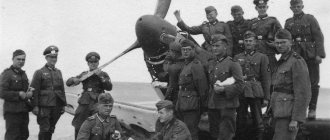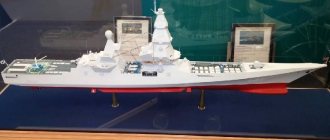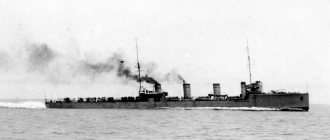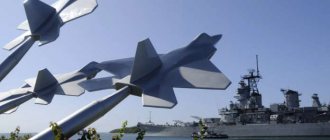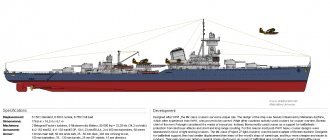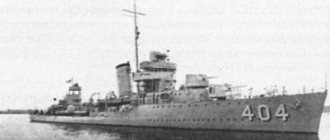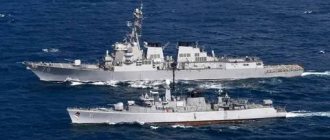The period of the Great Patriotic War
As you know, June 1941 is the beginning of the most difficult Second World War for Russia. The Nazis' plans were to capture Russian bases near the sea in St. Petersburg. Novik-class destroyers entered the fight against enemy Germany. All ships were lost mainly due to attacks by fascist planes or enemy mine installations at the very beginning of the Second World War.
The enemy troops planned to first capture the ships being repaired, so the units located in Libau were the first to take the blow. The legendary destroyer Lenin was also located there. The destroyer's crew showed incredible courage in battles on land. Then Afanasyev, the commander of the ship, ordered the ship to be destroyed. Then, on his orders, all weapons were removed for subsequent flooding next to the ship. All secret documents were burned. At night everything was destroyed by an explosion.
To close Leningrad from the sea, mine and artillery positions were created. “Noviks” took part - “Yakov Sverdlov”, “Artem”, “Karl Marx”, “Volodarsky”.
2nd series modification of the “Novik” type – destroyer “Lieutenant Ilyin”
At the end of the first month of summer, the ships arrived in Tallinn. Destroyers laid mines in the Gulf of Finland, subjected to unsuccessful air strikes.
Meanwhile, enemy troops created a threat to the artillery position in the Gulf of Finland. Then such a position was created in the eastern part of the bay. A detachment of ships spent days laying mines for a month. As a result, the enemy's affairs became more complicated.
"Engels" was located next to the barge "Spinoza", taking fuel. On August 7, signalmen discovered enemy aircraft flying quite high. The planes, entering from the left and right sides, dived one at a time. After gaining speed of 12 knots, the conning tower and navigation bridge located on the forecastle immediately went down. Bombs weighing 250 kilograms caused irreparable damage to the ship and barge, which began to sink. The ship's hull was badly damaged.
The situation in Estonia during the war was difficult, and the fighting lasted about thirty days for the capital. After the Nazis approached the outskirts of the city, the ships began to move to Kronstadt. The ships were moving towards St. Petersburg, which was under a serious threat.
More than 200 ships took part in the Tallinn crossing, which had to cover about three hundred kilometers. The transport transition was ensured by a naval fleet divided into three detachments:
- Chapter with Admiral V.F. Trubitsa;
- Cover with Panteleev Yu.A.;
- Rearguard with Yu.F. Rallem.
The threat to movement was posed by planted mines. The destroyer "Yakov Sverdlov" was moving to guard the ship "Kirov", right in front of which the "Proud" exploded, after a while the "Yakov Sverdlov" and "Kalinin" exploded. The warship broke in half, but miraculously stayed afloat for about an hour, during which time everyone on board was evacuated. The next one to blow up the world was “Artem”. At this point, the famous Noviki destroyers completed their journey, having suffered huge losses in the Tallinn breakthrough, but only thanks to them the main forces of the fleet were preserved and continued their journey. Monuments have been erected to the legendary ships.
History of creation
It all started with the fact that the committee sent Russian and foreign factories to inform them about the price and time frame for the construction of a mine cruiser with a high speed of more than thirty knots, which has good weapons.
Few factories were willing to take on a project with subsequent assembly without guarantees of receiving the main order. As a result, a competition was announced for the destroyer project; the winner could take on the order and have a guarantee of receiving a reward. The results of the competition were announced in January 1909. There were four projects, and in all of them it was proposed to use turbines of the Parsons system. In the end, the best was the development of the Putilov plant.
After a committee meeting was held and an agreement was concluded to build a cruiser with a speed of 66 km/h, or 36 knots, the order was transferred to the plant. Boilers and turbines that were developed by foreign factories could be ordered; this was strictly stated in the contract. The test was to be carried out after two years and four months from the date of conclusion and signing of the papers.
Selecting the optimal configuration
The main achievement in the development of the new body was a simultaneous reduction in the weight of the body and an increase in the weight of the mechanisms. Thanks to the low weight of the body, it became possible to install heavy turbines and boilers that heat up quickly due to the large heating area.
To make the new ship unsinkable, the hull was divided into separate compartments by bulkheads that prevented water from entering.
The design used the best quality shipbuilding steel, which retained its shape when exposed to the bending moment of a wave.
The location of all the premises as a whole was also successful. The rear part of the hull was occupied by boilers, the turbines were placed in engine rooms and separated by a bulkhead that did not allow water to pass through.
The rooms for the officers were located near the forecastle on the upper deck, the total number of cabins was 8. The crew was allocated a place to live next to the officers.
Construction and testing
The destroyer was tested for strength in March 1910 in the pool of a German factory. A 1:22 scale model was tested. The most interesting issue during the test was the possibility of resistance of the ship's hull. After the tests, the erroneous conclusion was made that the power of the mechanisms was not enough for this. Due to a factory oversight, construction was delayed for twelve months.
On July 19, 1910, the keel of the destroyer took place. The ceremony was very solemn. At the end of 1910, the ship was completely covered and decked. The water leak test took place early next year. The newest ship at that time was given the name “Novik”, which was previously borne by another legendary ship. 8.03. In 1911, Nicholas 2 approved the names. After this, Novik was included in the Imperial Navy.
In the same summer, the first launch of the new vessel took place. There was no celebration this time; on the second day, commanders were appointed who could supervise the installation and finishing of devices and mechanisms.
In the spring of the following year, the ship became more and more like a military one. In mid-April, before the next tests, a fire occurred in the boiler compartment. However, the delivery date has not changed due to the efforts made to restore the Putilov plant.
Description of design
The main distinguishing feature of Novik was its sharp contours. The composition of the hull was shipbuilding steel. Due to the considerable length of the body, it must be strong, to achieve this, steel with good resistance is used. The hull was divided into ten parts by watertight bulkheads. Thanks to this, it was unsinkable.
Power plant and driving performance
Major parts of the mechanical installation were made in Germany. Steam turbines of the German plant, made of steel and cast iron, were located on the sides and in the engine room. Steam was produced by water-tube boilers heated by oil. The required amount of oxygen for its combustion was supplied by special closed fans.
History of changes
After the ship entered service with the Russian Imperial Navy, naval experts developed a plan to improve the squadron. After the changes were made, several modification options appeared. For the defense of the Baltic, about forty ships of this type were laid down, divided into four main types. The first type of vessel is “Novik”. The second modification had the largest series and numbered twenty ships, built according to the type of the ship “Lieutenant Ilyin”. The next one was built according to the Izyaslav type, the fourth consisted of nine ships and was called Gogland.
The newest ships fought in battles in the Gulf of Riga and took part in laying mine barriers. The destroyers “Grom”, “Zabiyaka”, “Samson” took part in terrible battles with the German fleet approaching the Gulf of Finland.
Modifications
It is impossible not to mention two famous destroyers - “Grom” and “Daring”, built according to the shipbuilding program. These ships are very similar in their characteristics: they have approximately the same displacement, which is equal to more than one ton, length, width, draft, engines in the form of two steam turbines, speed, and a cruising range of almost two thousand miles. The difference between the destroyers “Daring” and “Thunder” is their power, the first has 30 thousand hp, the second only 23.5 thousand hp. Their differences also lie in the crew; the “Grom” has a crew of 40 more people and amounts to 150 people. The destroyer "Grom" has a more modern MTV from 1916, while the "Daring" mines installed on the ship are from 1908.
The first scout of the Russian fleet
“The Novik type cruiser is a huge destroyer weighing 3,000 tons with a 25-knot speed...” These words began the description of this ship in the “Report on the Maritime Department for 1897–1900.” Built in Germany by order of Russia, Novik turned out to be the fastest cruiser in the world, able to easily withstand a battle with numerous destroyers and, at the same time, escape from a stronger enemy. The appearance of this ship in the Russian fleet, in fact, anticipated the birth in other fleets of a new subclass of warships - light scout cruisers. Let us remember how Novik was created, as well as the short but bright combat path of this ship.
Design and construction
Victory over China in the war of 1894–1895 led to a sharp increase in Japan's ambitions in the East Asian region. However, Russia, acting in alliance with France and Germany, prevented the expansionist plans of the Land of the Rising Sun. Under the threat of war with the leading European powers, Japan had to return the Liaodong Peninsula with the Port Arthur fortress to China, which the Chinese then leased to Russia. Realizing that the Russian Empire would not voluntarily cede primacy in the Far East, Japan began preparations for war with it, placing its main emphasis on strengthening its fleet. In response to this, Russia adopted a shipbuilding program in 1895, which was continued and expanded in 1898. According to this program, the main Russian forces in the Far East by 1903 were to consist of ten squadron battleships.
In addition to other ships, each battleship was to have one armored cruiser of the 2nd rank with a displacement of 2500–3000 tons. Their main function was to conduct reconnaissance, transmit reports and protect the squadron from enemy destroyers. The main quality of such a cruiser should have been speed, even at the expense of other characteristics. In March 1898, the Marine Technical Committee (MTK) developed a program for designing a cruiser of the 2nd rank, according to which the ship’s displacement should not exceed 3000 tons, the speed should reach 25 knots, and the armament consisted of six 120-mm and six 47-mm mm guns, as well as six torpedo tubes. The cruising range was supposed to be 5000 miles using economic speed. The ship was protected by an armored deck of the maximum possible thickness.
After developing the technical requirements, a competition was announced for the best cruiser design, the winner of which was the German one. On August 5, 1898, a contract was signed with her for the construction of the future Novik. The ship's readiness period was set at 25 months (subsequently the delivery date was moved to December 5, 1900), and its total cost was 3,391,314 rubles.
Due to the long coordination of drawings between the designers and the Ministry of Transport and Communications, as well as delays in the supply of steel from factories, construction began only in December 1899, but progressed quite quickly. The official laying of the ship took place in Danzig on February 29, 1900 - by that time its hull had been brought to the level of the armored deck.
Assembly of the armored deck of the cruiser "Novik" Source: tsushima.su
Captain 2nd Rank Pyotr Fedorovich Gavrilov (his future commander) who observed the construction of the cruiser was delighted with the speed and accuracy of the work at the shipyard. According to his calculations, it turned out that the hull could be launched as early as May, that is, just six months after the actual start of construction. However, the launch took place a little later - in August, which was also a good result. In May 1901, Novik entered factory testing for the first time.
Novik in factory tests Source: kreiser.unoforum.pro
In a hurry to deliver the almost finished cruiser to the customer, the plant did not conduct progressive tests, when the power of the machines is gradually increased from one run to the next, but immediately decided to test the mechanisms at full power, accelerating the ship to 24 knots in the first test. According to P.F. Gavrilov, this was the reason why the tests were delayed. Of the seven test trips to sea, four had to be interrupted due to machine and propeller breakdowns. As a result, the cruiser remained at the factory for the winter. The tests were successfully completed only on April 23, 1902, after which the ship set off for Russia.
"Novik" on the Neva. In the background you can see the cruiser "Diana" and the battleship "Emperor Alexander III" being completed. Source: kreiser.unoforum.pro
Pre-war service
In May 1902, Novik arrived in Kronstadt, after which its preparations for overseas voyages began. On September 14, the cruiser set sail for the Far East. On September 26, he arrived in Naples, and then to the Greek port of Piraeus, where the Russian squadron was stationed at that time. On November 19, Novik moved to Poros Bay, where until December 5 the team was engaged in combat training. On December 1, its new commander, captain 2nd rank Nikolai Ottovich von Essen, boarded the cruiser. In his letters to his wife and son, von Essen shared the positive impression that Novik made on him, in particular, noting the high saturation of the ship with electrical mechanisms.
"Novik" on the roadstead of Brest, 1902 Source: kreiser.unoforum.pro
On December 11, “Novik” left Poros Bay, however, when it went out to sea, it encountered a severe storm, accompanied by a blizzard. In his report, Essen noted the strong roll and regretted the lack of side keels on the cruiser that would help reduce it. At the same time, when sailing against the wave, the cruiser held up perfectly, experiencing only slight rolling. Unable to withstand the storm, “Novik” took refuge from the elements in Salamis Bay and left there a day later. Having reached Port Said, the Novik passed the Suez Canal and continued its journey through the Indian Ocean. On February 28 he arrived in Singapore, on March 9 - in the Philippines. On March 17, Novik was assigned to the Pacific squadron, and on April 2 it reached Port Arthur.
Here tests began again on the cruiser. On April 22, during tests at maximum speed, the Novik showed 23.6 knots. This was followed by a joint transition with the cruiser Askold to Vladivostok. On May 16–17, the Russian Minister of War, Adjutant General A.N. Kuropatkin, arrived on board the Novik in Posiet Bay. Then “Novik” and “Askold” acted in an unusual role for them as yachts, accompanying the minister during his visit to Japan in May-June 1903. The end of June and the first half of July were spent for Novik in joint exercises and voyages with the squadron, after which the period of the so-called “armed reserve” began, during which the ships were in the port of Vladivostok. Already on August 31, Novik set off for Slavyanka Bay to carry out torpedo firing training and destroy deviations. The ship was repainted in a protective dark olive color, and on September 18 it arrived in Port Arthur along with the rest of the squadron.
On September 24, while anchored, the stern of the Yenisei mine transport was dumped onto the bow of the Novik by a storm wind (with minor damage to the stem and plating in the bow). Russian sailors estimated the repair time on their own at three days.
In the fall of 1903, diplomatic relations between Russia and Japan worsened. At this time, the ships of the squadron, based in the port of Dalniy, were engaged in joint exercises and practicing repelling mine attacks. On October 19, after the alarm was cleared, the squadron returned to Port Arthur, where on November 1 the next period of “armed reserve” began for it.
In the new year, 1904, the squadron’s first departure to sea took place on January 21–22, after which the ships remained in the outer roadstead of Port Arthur. The sailors did not know about the severance of diplomatic relations with Japan - not wanting to “bother” the crews, the Russian governor in the Far East did not announce this. However, the premonition of the imminent outbreak of war was in the air. However, all attempts by the ship commanders to take security measures were suppressed by the governor. Every night the sailors prepared to repel mine attacks, but without creating an effective screen of patrol ships capable of intercepting attackers at a distance from the squadron, such measures were useless.
"Novik" in protective paint. In the background is the battleship Pobeda. Port Arthur, 1904 Source: tsushima.su
On the evening of January 26, an order was received from the flagship battleship Petropavlovsk to go to sea the next day. Then an order was received to prepare to repel a night mine attack, but not to load the turret and 152-mm guns. According to Lieutenant A.I. Sheikovsky, in the evening the Novik commander told the officers: “I am sure, gentlemen, that the Japanese will attack us before war is declared...”
In defense of Port Arthur
The Russo-Japanese War began late in the evening of January 26 with a surprise attack by Japanese destroyers on a Russian squadron stationed on the outer roadstead of Port Arthur. "Novik", one of whose tasks was to protect Russian ships from mine attacks, at the time of the attack was almost in the rear of the squadron (near the passage to the internal roadstead). The cruiser sounded the combat alarm and began to urgently create steam in the boilers, but were unable to prevent the attack. After the Novik set off, four silhouettes were noticed from it, moving away from the squadron towards the open sea. The Novik was unable to catch up with the enemy - at 2:35 the silhouettes disappeared from view, and the cruiser returned back to the squadron. On the morning of January 27, the Russian squadron began to prepare for battle, in case the Japanese came to verify the effectiveness of the night attack.
This is exactly what happened. At 8 o'clock in the morning, Japanese fast cruisers sent on reconnaissance appeared in the field of view of the Russian squadron. Soon the Russian cruiser Boyarin, previously sent on reconnaissance, appeared and fired from its stern gun towards the enemy. A report was received from "Boyarin": "I see the enemy in large forces"
. Ten minutes later, Japanese battleships appeared on the horizon. "Novik" weighed anchor and headed towards the enemy. The Russian battleships were just beginning to move, and therefore the Novik with other Russian cruisers found themselves between the main forces of both sides.
At 11:10 the Japanese opened fire on the Novik. Thus began the first battle of the main naval forces in that war. "Novik" was closest to the enemy, causing a barrage of shells. Whether luck favored the ship, defenseless against heavy shells, or skillful maneuvering, the cruiser remained unharmed for quite a long time. Only at 11:40 (according to the entry in the logbook, the time may have been indicated inaccurately) an enemy shell hit the cruiser on the starboard side just below the waterline. For some time, Novik got so close to the Japanese squadron that from the outside it looked as if it was launching a torpedo attack on the Japanese flagship. At the same time, neither Essen’s report to the squadron commander, nor the letter to his wife written by him the day after the battle, says anything about such intentions. There is no mention of them in the memoirs of Lieutenant A.P. Shter. Most likely, the Novik commander really had no such intentions. Von Essen could not help but understand that his cruiser would die under the concentrated fire of an entire squadron before approaching the enemy within range of an effective torpedo salvo. Nevertheless, Novik’s bold actions had a beneficial effect on the morale of Russian sailors. According to the memoirs of A.P. Shter, after the battle, Novik was enthusiastically greeted in the harbor by eyewitnesses of the battle who were watching it from coastal positions. During the battle, the Russian cruiser fired one hundred and five 120-mm shells at the enemy (the Japanese did not report anything about hits from the Novik).
An examination of the hole revealed that the shell that hit the cruiser did not cause serious damage to it. The armored deck withstood the impact, limiting damage to the freeboard. The 120 mm gun was damaged by shrapnel and the officer's cabin was destroyed. Also, the blast wave tore off the right kingston of the aft cartridge magazine, which was consequently flooded. Following this, water flooded the steering compartment (however, the steering gear did not fail). One of the gunners was seriously wounded by fragments of this shell (he died in the hospital shortly after the battle). Later, for the battle on January 27, Essen was awarded a Golden Saber with the inscription “For Bravery,” and 12 Novik crew members received St. George’s Crosses.
A hole from a shell received on January 27, 1904 Source: navsource.narod.ru
On January 30, Novik was docked to repair the hole, and on February 8, the repairs were completed. From now on, Novik was part of a detachment of cruisers under the command of Rear Admiral M.P. Molas, along with Bayan, Askold, Diana and Pallada. During daily service, the cruiser was operated very intensively, constantly being in a state of immediate readiness for combat (most often she had to go out to support destroyers). The first exit took place on February 11, and the very next day the Novik, together with the Bayan and Askold, went to sea to support the destroyers of the 1st detachment and found themselves face to face with the main forces of the Japanese Admiral Heihachiro Togo. For twenty minutes, until the signal to retreat came, three Russian cruisers were under fire from twelve armored ships, boldly responding to them with their guns. The sea around the Russian ships was boiling with explosions, but, fortunately, not a single Japanese shell hit the target - luck was with the Novik again.
On February 24, the new squadron commander, Admiral Stepan Osipovich Makarov, arrived in Port Arthur. With his arrival, the activity of the Russian squadron increased sharply. On February 26, the enemy intercepted the Russian destroyers Reshetelny and Steregushchiy, returning from night reconnaissance. “Resolute” managed to break into the harbor, and “Guarding” was surrounded by superior Japanese forces. The unequal battle took place in front of the entire fortress. Makarov himself immediately came to the rescue of the Guardian on the Novik, as well as the cruiser Bayan. Unfortunately, by the time the cruiser reached the battlefield, scaring off the Japanese, the Guardian had already sunk. As more Japanese ships appeared on the horizon, Novik and Bayan returned to the harbor.
On February 27, the Novik went to sea again - this time as part of the entire squadron. On March 9, he went out on reconnaissance with the cruisers Bayan, Askold, Diana and destroyers. On March 12, "Novik" made an exit towards the Russian destroyers. On March 13, the squadron went out to sea for reconnaissance - the Novik captured the Japanese ship Hanien Maru, on board which several Japanese saboteurs and an old rusty mine were found. The Japanese were captured and the ship was scuttled after a failed towing attempt. On March 14, Novik made another trip to sea (with a squadron) and fired at Japanese destroyers. On March 25, he carried out guard duty on the outer roadstead, and on March 29, he participated in the squadron’s next exit (a commercial steamer was inspected). As you can see, Novik was used very intensively, turning out to be the most popular ship of the squadron.
"Novik" in Port Arthur. In the background is the battleship "Retvizan" Source: navsource.narod.ru
Meanwhile, in March 1904, there was a change of commander on the cruiser. N.O. von Essen was appointed commander of the battleship "Sevastopol" to replace the guilty captain of the 1st rank N.K. Chernyshev and on March 17 transferred command of the "Novik" to captain 2nd rank M.F. von Schultz, whom he described as "brave" , an energetic and courageous officer, into whose hands it would not be a shame to give up your cruiser"
.
On March 31, a terrible misfortune befell the Russian squadron in Port Arthur - the battleship Petropavlovsk, along with Admiral Makarov and his staff, was killed by a Japanese mine. The emerging rise in morale gave way to terrible despondency. Suffice it to say that three Novik officers - its commander von Schultz, midshipmen S.P. Burachek and K.N. Knorring - lost their brothers on Petropavlovsk. The degree of depression of the ship's crews and the squadron command is evidenced by the fact that during April the Novik never went to sea. Only after the death of the Japanese battleships Hatsuse and Yashima on May 2, which were blown up by Russian mines, did the squadron begin to make at least some attempts to influence the enemy. On May 5, 14 and 22, Novik went out to cover the Amur mine transport, which was trying to develop its success with new mine layings.
Starting in June, Novik, together with destroyers, began to go out to cover Russian ships that were shelling the coastal flank of the Japanese army. During June-July, 11 such exits were made, during which Novik fired about 900 shells from 120-mm guns at enemy coastal positions. There were repeated skirmishes with enemy destroyers, during which Novik showed its complete superiority over them, despite the overwhelming numerical superiority of the Japanese. Accurate artillery fire from the cruiser prevented the Japanese destroyers from approaching torpedo firing range, while the high speed of the Novik prevented the enemy from attacking from advantageous heading angles. For his skillful command of the cruiser in these battles, the commander of the Novik, Captain 2nd Rank von Schultz, was awarded a Golden Weapon with the inscription “For Bravery.”
Alas, using the Novik “for wear and tear” could not but lead to sad consequences. Despite the efforts of the ship's mechanics, the cruiser's constant 40-minute readiness for departure led to the condition of its boilers and machinery deteriorating sharply (for the same reason, it was not possible to carry out a major overhaul of the boilers). Even on July 27, on the eve of the squadron’s breakthrough from Port Arthur to Vladivostok, Novik went out to shell the coast and therefore was unable to receive a full supply of coal.
Novik's finest hour
On July 27, a meeting of cruiser commanders was held on the Askold, at which the head of the cruiser detachment, Rear Admiral N.K. Reitsenstein, set his subordinates the task of breaking through to Vladivostok, regardless of any circumstances. Early in the morning of July 28, Novik entered the outer roadstead, waiting for the rest of the squadron's ships. After the start of movement, he took the leading position in the formation, showing the way to the trawling caravan and warning the following ships about floating mines. After the main enemy forces appeared on the horizon, Novik returned to duty, taking its place behind the lead cruiser Askold.
The cruisers practically did not participate in the battle of the main forces of the two fleets. Only at 12:45, after his ships dangerously approached the Japanese battleships, Reitzenstein ordered to increase the distance to the enemy by moving to the non-firing side of the Russian battleships. After the failure of the flagship battleship Tsesarevich and the loss of control of the squadron, the Russian admiral decided that the turning point of the battle had come and led his ships to a breakthrough. At about 18:45, the signal “Cruisers follow me” went up on the Askold’s mast. Having developed maximum speed and continuously firing at the advancing Japanese destroyers, Askold and Novik headed south (towards the open sea), taking advantage of the fact that the Japanese had not yet managed to block this direction. The slow-moving Diana and Pallada fell behind and returned to the squadron. The Japanese armored cruisers Asama and Yakumo tried to prevent the breakthrough by starting a battle with Askold, but failed and remained astern. In that battle, Askold received heavy damage, but managed to drive away the enemy, thereby ensuring the success of the breakthrough. But the Japanese cruisers of the 3rd and 5th combat detachments managed to inflict damage on the Novik - two sailors were killed by three hit shells, the ship's doctor was slightly wounded and the bow searchlight was broken. Fortunately, the cruiser did not suffer serious damage, since all the holes turned out to be above water.
At about 20 o'clock the darkness covered the Novik and Askold from the Japanese pursuing them, and after half an hour the battle stopped. At 20:40, Novik caught up with Askold, and both ships continued their journey to the southwest. Soon Novik began to lag behind - the condition of its mechanisms was critical. Algae filled the refrigerators of the cars, as a result of which the salinity of the water in the boilers greatly increased, and the air pumps began to overheat. On-board vehicles were stopped to inspect and clean the refrigerators, as a result of which the cruiser's speed was greatly reduced. Numerous signals about the need to reduce speed on the Askold were not understood, and soon the flagship cruiser disappeared into the darkness. Reitzenstein later wrote that the signals were perceived on the Askold as requests to let the Novik go on an independent voyage, which was done. Be that as it may, Askold disappeared into the night, and the Novik team began repairing the mechanisms. To add insult to injury, the water pipes in the boilers began to burst, forcing them to be turned off one by one.
The night passed while troubleshooting. In the morning, a meeting took place with the cruiser "Diana" and the destroyer "Grozovoy", but each commander preferred to act independently in the future. In particular, Novik intended to call for coal in Qingdao, and then follow to Vladivostok, rounding Japan from the east. Having parted with the Diana and Grozovoy, at 17:25 the Novik entered the port of Qingdao, after which negotiations began with the German governor about the provision of coal. The negotiations dragged on, and Russian sailors began loading coal only at 20:45. Already at 3:30, loading was stopped, having received only 250 tons, and half an hour later the cruiser went to sea to pass in the dark past Japanese ships that could be on duty at the entrance to the harbor.
There was no enemy at sea, and the Novik set off on its journey around Japan. Due to the lack of coal, the speed was very low, but even with the most economical progress, there was only enough fuel to reach Vladivostok. The slightest increase in coal consumption made the possibility of achieving the goal very vague. Saving coal, Novik took the shortest route, which is why it was forced to pass near Tokyo, where it was noticed from the Celtic steamer. On August 6, the cruiser passed the Kunashir Strait, not avoiding detection from the shore. Meanwhile, it became clear that there would still not be enough coal to reach Vladivostok. To replenish supplies, it was decided to go to the Korsakov post, located at the southern tip of Sakhalin.
Novik’s route around Japan Source: tsushima.su
Last Stand
On the morning of August 7, Novik arrived at the Korsakov post. The situation with coal on the cruiser was critical, so the team immediately began to replenish its reserves. In addition, work began on repairing burst pipes in boilers. However, the respite was short-lived - already at 14:30 telegraph operators intercepted communications of approaching Japanese ships. However, loading of coal continued for some time. By 16:00 it was possible to separate steam in seven boilers, and at 16:25 smoke was noticed from the south. At 16:30, the Novik weighed anchor, and the speed was increased to 20 knots. The quickly approaching enemy was identified as the cruiser Niitaka (after the battle it became known that it was the cruiser Tsushima of the same type). At 17:10 the first shots were fired - at that moment the distance between the opponents was 40 meters. Five minutes later, the Japanese cruiser laid down on a course parallel to the Novik, firing on the left side, and the Russian ship responded with guns on the starboard side.
Japanese cruiser Tsushima in 1905 Source: tsushima.su
At 17:20, a Japanese shell that hit below the armored deck made a hole in the steering compartment of the Novik. At 17:30, a second shell exploded in the area of the aft bridge, and another destroyed the command and navigation rooms. At 17:35 the fourth shell hit the steering compartment, which was completely flooded as a result. The cruiser now had a stern trim of 0.8–0.9 m, and water began to fill the crack compartment, which further increased the trim. By 17:40 on the Novik, the aft cartridge magazine was flooded, some of the other rooms in the aft section were flooded, and the steering wheel began to become difficult to obey. At 17:50, due to the desperate situation of the cruiser (progressive flooding, almost complete failure of the steering, loss of speed due to the failure of part of the boilers), the commander decided to stop the battle and return to the Korsakov post. By this time, the trim aft was already 1.8 m.
The Japanese cruiser also turned aside and stopped at 17:55. It showed a strong list to starboard - according to the Novik sailors, there were hits in the “bridge, side and especially the stern”
. However, according to the Japanese official naval history, the cruiser Tsushima received a single hit, which caused the flooding of two compartments and a list. In any case, the damage to the Tsushima was severe enough to put it out of commission for some time.
At 18:10, the steering on the Novik completely failed (by this time the battle had stopped due to the increased distance between the opponents). At 18:40, Novik came closer to the shore, and the Japanese cruiser slowed down and began to move towards the sea. Due to the severe damage received by the Novik, the approach of reinforcements to the enemy and the Japanese control of the exit from the bay, von Schultz decided to sink his ship. At 19:00, the evacuation of the crew to the shore began, and at 23:00, the seacocks were opened on the cruiser. At 23:30 he lay down on the ground with a list to starboard, while part of the deck and pipes remained above the water. The Russian sailors did not blow up the cruiser, as they hoped that after the war they would be able to raise it and put it into operation.
The sunken Novik on the rocks near the Korsakov post Source: forums.airbase.ru
In the last battle on the Novik, two sailors were killed, two more later died from wounds, and eleven people were wounded. Most of the crew, led by the commander, was called to Vladivostok. To get there, 264 sailors, led by seven officers, made a difficult trek on foot to the village of Aleksandrovsk, covering a distance of more than 600 miles in 45 days, and then went to Vladivostok by transport.
28 sailors and 3 officers were left at the Korsakov post to defend the Novik and remove its guns. They managed to remove all the guns, some of the shells and a large number of valuables and equipment from the cruiser. Some of the guns were installed on the shore in improvised shelters and strengthened the defense of the island. The cruiser's hull was blown up when it became clear that the Japanese could land on Sakhalin. The sailors from Novik took part in the short-lived defense of the island, which ended with its capture by the Japanese (some of the sailors, led by midshipman A.P. Maksimov, were captured). For the defense of Sakhalin, 23 sailors were awarded the insignia of the Military Order of St. George, 3rd degree, and two more - 4th.
In the service of the Japanese
Despite the serious damage to the Novik's hull resulting from its explosion, immediately after the Japanese occupied Sakhalin, work began on raising the ship. Already in July 1906, the hull was towed to Japan for restoration, and in 1908 the cruiser became part of the Japanese fleet under the name Suzuya. During restoration, the cruiser was quite significantly changed - now its armament consisted of two 152-mm guns located on the forecastle and poop, as well as four 120-mm Armstrong guns. In addition, 8 new Miyabara system boilers were installed on the cruiser, and the bow boiler compartment, along with the bow pipe, was eliminated. At the same time, the ship's speed decreased to 19 knots. A few years later, in order to lighten the cruiser, the 120 mm guns were removed from it, and six 76 mm, six 47 mm and two 37 mm guns were installed instead. The cruiser's service under the Japanese flag was short-lived and unremarkable - on April 1, 1913, she was excluded from the lists of the fleet, and a little later she was dismantled for metal.
Assessing the cruiser project, it should be said that it turned out to be very successful. “Novik” fully met the requirements that were placed on it during the design. Combining high speed, fairly strong weapons and small size, it successfully served as a reconnaissance officer, defender of Russian destroyers and was a serious threat to enemy destroyers. The high quality of construction allowed it to carry out active operations for a long time, despite operation “for wear and tear.” Based on the Novik project, two more cruisers were built in St. Petersburg (“Zhemchug” and “Izumrud”), which developed lower speeds but were better armed. The Novika project did not go unnoticed abroad either. Based on Russian experience, several series of reconnaissance ships were built in England, Germany, Italy and the USA, which later became known as scout cruisers and took an active part in the First World War.
Cruiser "Suzuya", 1908 Source: tsushima.su
Tactical and technical characteristics of the cruiser "Novik"
| Normal design displacement (full), t | 3000 (3140) |
| Maximum length, m | 110,5 |
| Maximum width, m | 12,2 |
| Draft, m | 5 |
| Number of steam engines | 3 |
| Total design (actual) power of machines, l. With. | 17000 (17789) |
| Maximum design speed, knots | 25 |
| Coal reserves are normal (full), t | 360 (500) |
| Design cruising range (actual), miles | 5000 (3200) at 10 kts |
| Conning tower thickness, mm | 30 |
| Armored deck thickness, mm | 30–50 |
| Artillery weapons, number of guns – caliber, mm | 6–120 |
| 6–47 | |
| 2–37 | |
| 2 machine guns | |
| Torpedo armament, number of devices - caliber, mm | 5–381 |
Bibliography
- Shter A.P. On the cruiser “Novik”. – St. Petersburg: Gangut, 2001
- Emelin A. Yu. Cruiser “Novik”. Fighter of fighters. – M.: Yauza: Eksmo: Gangut, 2014
- Polomoshnov E.V. Fight July 28, 1904. – printing house of JSC “Kant”, Novosibirsk, 2004
- Krestyaninov V. Ya. Cruisers of the Russian Imperial Navy 1856–1917. Part 1. – St. Petersburg: “Galeya Print”, 2009
Armament of Novik-class destroyers
The artillery consisted of 4 guns with a sixty-caliber barrel, which were located on the forecastle and near the stern bridge. The gun itself consisted of a pipe, fastened with cylinders in three places, a bolt and a compressor with a knurled device. Almost all equipment for the attack was manufactured at the Obukhov plant. Spare cartridges were stored in cellars. The distance to the target was determined using a British rangefinder mounted on the running bridge. The rate of fire was 10 high/min, which was a good indicator for that time. Along the perimeter of the side there were the famous four Maxim machine guns of 7.62 caliber. Their rate of fire was 600 rpm.
However, newcomers from different series have different weapons. So, for example, if we take “Fidonisi”, “Lieutenant Ilyin” and “Orpheus”, they have the same artillery and number of mines, but different torpedo armament. Thus, the destroyer Fidonisi has two machine guns, while the Lieutenant Ilyin has only one. These ships also differ in the number of torpedoes, if the first has 14, the second has only 9. We can conclude that the ships’ armament was constantly being improved in order to improve results in battle.
Mine and torpedo weapons
The Russian mine weapons on this ship had to be effective and highly reliable. The composition included torpedo tubes that can be deployed completely around their axis. There was manual and long-range firing control, which increased combat effectiveness significantly. The speed of the torpedo was forty knots, the flight range was from one to six and a half kilometers.
Double-pipe torpedo tube
It is impossible not to mention the presence of a torpedo, first used by Makarov in the Russian-Turkish war, which became the real pride of Russian weapons.
The ship was equipped with four two-pipe apparatus with a caliber of 450 millimeters, which provided for the storage of the torpedoes themselves. They were located between the first and fourth pipes, as well as near the guns. To make it possible to load and feed torpedoes, beams with winches were developed. Despite the fact that during the creation of modifications the number of torpedoes in a salvo was doubled, these devices were one of the disadvantages of the destroyer. The device rotated very slowly, which hindered a rapid attack, did not have a sight coupling, and the charging bolt was unfinished.
The mine armament included about fifty mines, which could be installed at a speed of no higher than 24 knots. They were stored and installed using special ramps and rails.
Auxiliary equipment
The ship used a steering wheel with a steel frame, which was made using modern techniques at that time. Telegraphs powered by electricity were used to control steam engines. Intra-ship communications have been developed - communication pipes, alarms and telephones. It should be noted that there are several magnetic compasses, a sextant, instruments for measuring timekeeping and a line for extinguishing fire in the event of a fire.
A few words about destroyers
Sailors have long tried to attach mines to naval service. Even the ancient Chinese suggested placing them and waiting on the shore for an enemy ship to sail past and be blown up. What if it doesn’t float, and what if it doesn’t explode? And again, it’s a pity for time. In general, at the end of the 19th century, military thought reached pole mines.
A pole mine is a long stick, at the end of which is attached, in fact, a mine with a contact or electric fuse. A pair of such sticks is placed on a small ship, the crew puts on clean underwear and goes to ram the enemy ship. Poking him with a mine until it finally explodes, and then trying to get away with it. It is clear that it is better to do this at night, in bad weather. This is how mine boats and destroyers appeared.
Steam mine boat with pole mine
The next stage was throwing mines - fired from a device and moving by inertia in the water. The distance still remained pistol-level (up to 40 meters), but still greater than that of pole-guns.
Then the mines were taught to move independently underwater and were soon called torpedoes. With them it became a little less scary, and the chances of running away became a little more.
Torpedo carriers formed a new class, which in Russia was named after the old name of the ammunition: “destroyers.” The word has stuck, so why philosophize? After their appearance, these new ships immediately - like all the others - began to grow in size.
Soon the fleet demanded destroyers capable of operating as part of squadrons, and not just close to the shore. They were logically called destroyers, that is, destroyers. Initially, these were exclusively auxiliary ships: set up smoke, throw torpedoes, suppress enemy destroyers with artillery fire. For some time, the latter function was considered the main one, which is why destroyers were initially called counter-destroyers or fighters. The latter term - Destroyer (in English) or Zerstörer (in German) - is still used in the West.
Falcon-class destroyer "Striking"
At the beginning of the last century, destroyers became an independent class of ships capable of solving serious problems. And this happened largely thanks to the creation of the Russian destroyer Novik. At that time, destroyers were divided into subclasses that were opposite in meaning: some had torpedo armament, others had artillery - in order to prevent the former from getting closer and using their torpedoes. However, it turned out that both roles can be combined.
Project evaluation
At the beginning of the twentieth century, ships such as the Novik were considered the most reliable and best. The latest developments were very different from their predecessors, making these ships an indispensable weapon in the First World War, but the legendary destroyer made its contribution to the defense of the country from enemy attacks during the Great Patriotic War. These are the first multi-purpose vessels of their kind. They have great speed, high maneuverability, excellent weapons, and during their entire service they successfully coped with such tasks as patrol, reconnaissance, and raid. During the Great Patriotic War, they proved themselves to be autonomous vessels with good adaptability to bypass mine outposts and protect the main maritime transport.
Life after death?
In June 2022, the Russian expedition “Bow to the Ships of the Great Victory,” together with Finnish search engines SubZone, discovered the remains of the destroyer Novik in the area of Cape Juminda east of Tallinn. Russian historian Mikhail Ivanov helped the search. He discovered in the Luftwaffe archives a report about an erroneous bombing of an underwater object, mistaken by German pilots for the Soviet submarine Shch-406. By the time of the bombing, this submarine had already been lost, and Mikhail Ivanov suggested that the remains of the destroyer could be found there. This is what the current expedition has confirmed.
Now flotophiles across the country have a glimmer of hope - a decision will probably be made to raise and restore the ship. Novik definitely deserved it.
